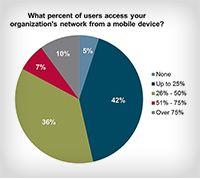If a survey of 96 attendees at Interop (News - Alert) is any indication, the “bring your own device” trend is already standard enterprise operating procedure, whether or not full policies have already been put into place.
Some 95 percent of respondents report they routinely connect PCs, smartphones, tablets and external USB drives to the enterprise network because their organizations allow it, according to Network Instruments.
That data largely validates a prediction by Gartner (News  - Alert) that, by 2017, possibly 50 percent of enterprises will require employees to provide their own computing or communications tools, especially smartphones. In other words, in a step beyond “you may use your own devices,” perhaps half of enterprises will mandate that users supply their own devices.
- Alert) that, by 2017, possibly 50 percent of enterprises will require employees to provide their own computing or communications tools, especially smartphones. In other words, in a step beyond “you may use your own devices,” perhaps half of enterprises will mandate that users supply their own devices.
Some 38 percent of companies expect to stop providing devices to workers by 2016, according to a global survey of CIOs by Gartner.

Those forecasts, if borne out, indicate that an inflection point in enterprise computing has already happened.
"BYOD strategies are the most radical change to the economics and the culture of client computing in business in decades," said David Willis (News - Alert), vice president and distinguished analyst at Gartner.
About 97 percent of the respondents connect their own notebooks to the enterprise network, 79 percent connect their smartphones, 70 percent connect their tablets and 34 percent connect external USB drives.
However, only one-third of these companies have specific BYOD policies in place.
When listing the biggest challenges in managing portable devices, 51 percent indicated identifying and tracking mobile devices as the major concern. This was followed closely with tracking security vulnerabilities and patches at 47 percent, and troubleshooting portable devices causing problems for 42 percent of the survey participants.
When allowing users to bring portable devices, 54 percent reported improved end-user experience, compared to only eight percent of end users reporting deteriorating conditions, Network Instruments says.
Nearly 41 percent responded that their ability to monitor application performance worsened after allowing users to connect via their own devices; this compared to 17 percent who saw improved monitoring. Similarly, 38 percent indicated troubleshooting became more difficult after allowing the use of personal portable devices.
One might agree that policies to protect confidential and proprietary information are necessary, without agreeing that a major problem generally exists at most organizations. The widespread use of personally-owned devices, with the relative lack of formal policies probably means that the ways personal devices are used does not generally involve unrestricted access to sensitive data.
Edited by Rich Steeves
